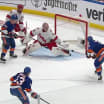As for defensemen, at 5-on-4 they take 0.659 penalties per 60 minutes and draw 0.145, for a differential of minus-0.514. At 5-on-5, defensemen average 0.573 penalties per 60 minutes and draw 0.297, for a differential of minus-0.276. They take 0.360 penalties per 60 minutes at 4-on-5 and draw 0.441, for a differential of plus-0.081.
So, the more ice time a defenseman gets, the worse his cumulative penalty differential should be. And both forwards and defensemen who play a lot of power-play minutes should also have worse differentials than those who don't.
With that information, I calculated the expected penalty differential for each player, based on position played and ice time in each of these manpower situations.
In 2016-17, McDavid played 1,345.6 minutes at 5-on-5, 235.3 minutes at 5-on-4 and 68.9 minutes at 4-on-5 in 2016-17. An average forward playing those same minutes would have drawn 18.0 penalties and taken 16.1, for a penalty differential of plus-1.9. McDavid drew 41 penalties and took nine in those three situations, for a penalty differential of plus-32, or 30.1 higher than expected.
The numbers won't add up exactly to his overall NHL totals, because some penalties are taken and drawn in other situations, such as 3-on-3 overtime, or 5-on-3 power plays.
When applying this approach to every NHL player, McDavid leads the League at plus-30.1, followed by Gaudreau (plus-22.5) and Ellis (plus-20.1).
So, if McDavid is worth 30.1 extra power-play opportunities per season, and his team were to score on 19.1 percent of its power plays (the League average), then he would be worth an extra 5.75 goals per season. Last season, Edmonton scored on 22.9 percent of its power plays, ranking fifth in the League.
Studying the relationship between a team's goal differential and points in the standings during the past decade, it takes approximately a three-goal improvement in a team's goal differential to add one point. That means that adding 5.75 goals per season is worth about two points in the standings.
Will McDavid's success continue this season? Judging by all the numbers over the past few seasons, the NHL's best players at drawing penalties can consistently give their team an advantage.
Barring an unlikely scenario in which McDavid plays more of a defense-oriented role this season, it's reasonably safe to predict that he should continue to give the Oilers a decided edge in power plays.


















